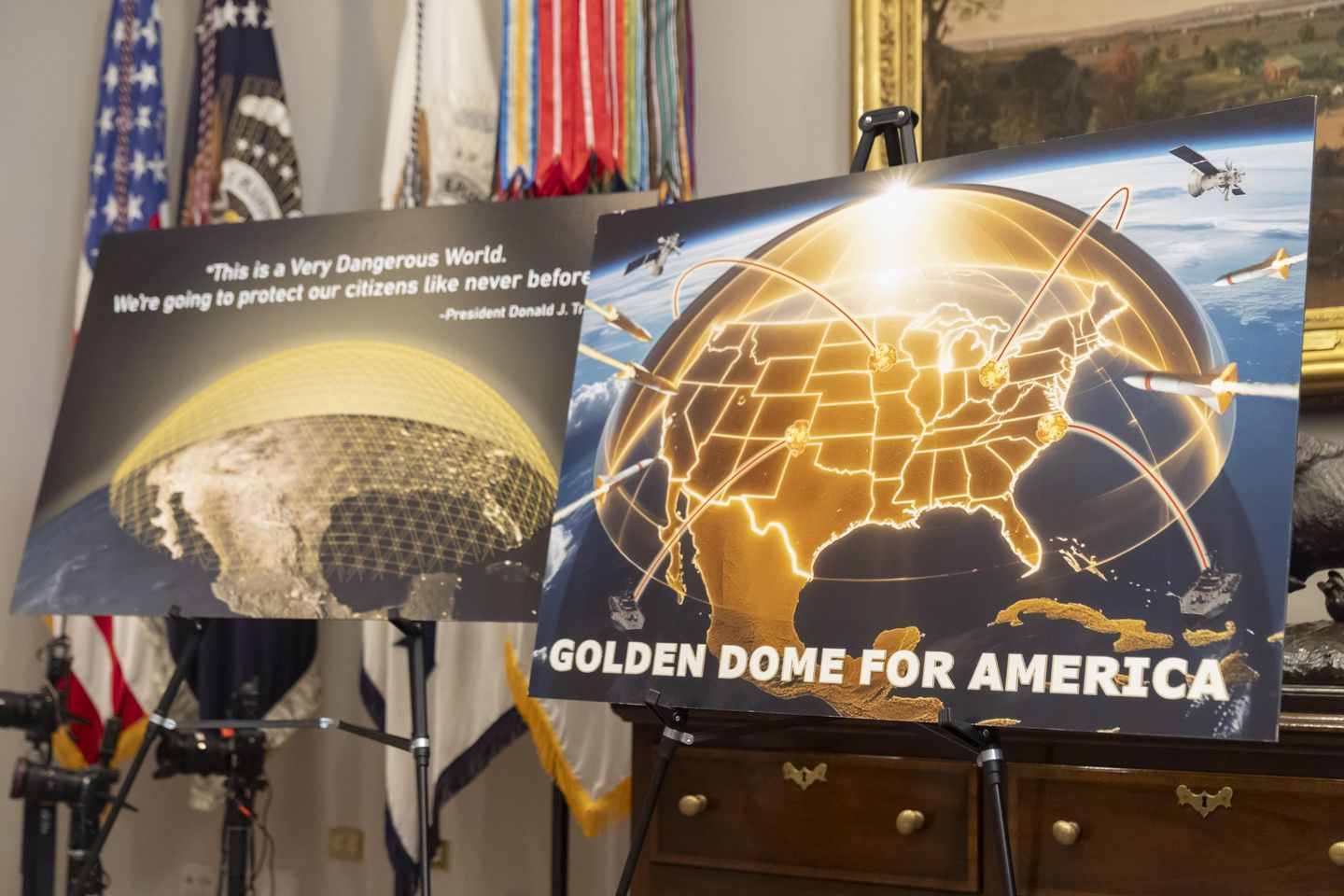
China is working against President Trump’s Golden Dome plan for a nationwide strategic missile defense system covering the United States as destabilizing and threatening its large missile forces, according to an Air Force think tank report.
Chinese Defense and Foreign Ministry officials also criticized the new missile defense system announced in February that is expected to include space weapons as likely leading to an arms race in space.
“The initial responses in the People’s Republic of China to Golden Dome have been overwhelmingly negative, with Beijing raising both strategic and normative objections to the U.S. reviving its past efforts to build a strategic missile defense system,” says the report by the Air Force’s China Aerospace Studies Institute.
China’s objections include claims that the missile shield will undermine strategic stability by weakening mutual deterrence despite Beijing’s massive expansion of its nuclear forces and missile programs.
According to the report, leaders of the Chinese Communist Party and its People’s Liberation Army have voiced specific concerns about Golden Dome’s plans for “active launch suppression” — viewed by Beijing as a U.S. threat to conduct preemptive attacks on Chinese nuclear missile forces.
Chinese officials also have criticized Golden Dome as reflecting what the report said is a U.S. “Cold War mentality” — Beijing code for anti-communist security policies.
Chinese sources also “sometimes portray U.S. missile defense as a protection racket, with allies forced to pay in or suffer consequences,” the report said.
In addition, China is promoting U.S. and foreign critics of the missile shield in propaganda outlets by raising questions about whether Golden Dome is affordable and technically feasible.
Much of the Chinese criticism reflects both Beijing’s and the Soviet Union’s opposition to President Ronald Reagan’s Strategic Defense Initiative in the 1980s.
Details about Golden Dome remain closely held within the Pentagon. The plan calls for an integrated air and missile defense system to be deployed by 2029.
The plan will include a four-layer system of defenses against multiple types of missiles, aircraft and drones, according to government briefing slides disclosed by Reuters last week.
The layers include satellite-based weapons along with three land-based defense systems, including 11 short-range anti-missile batteries located in the continental United States and in Alaska and Hawaii.
Chinese Defense Ministry spokesman Sr. Col. Wu Qian said in February that the United States “does not need an ’Iron Dome’ but must instead break through the ’Iron Curtain’ imprisoning its own thinking,” the report said.
Reaction from China
“China urges the U.S. to jettison its Cold War mentality, stop exaggerating threats from other countries, and cease manufacturing military confrontation,” Col. Wu said.
At the Foreign Ministry, arms control director Sun Xiaobo said in April at an international meeting on the 1970 Nuclear Non-Proliferation Treaty that China opposes American plans to spend $1.7 trillion modernizing its nuclear arsenal at the same time it develops the Golden Dome.
The nuclear modernization and Golden Dome would “seriously damage the legitimate rights and interests of other nuclear-weapons states, increase the risk of unnecessary nuclear confrontation and conflict, gravely undermine global and regional strategic stability, and greatly worsen the international environment for nuclear disarmament,” Mr. Sun said.
The cost to build the Golden Dome has been estimated at $175 billion. Congress approved the first $25 billion contained in the reconciliation bill signed into law July 4.
A Defense Intelligence Agency report made public in May identified threats posed by China’s large force of ballistic, cruise and hypersonic missiles as a key rationale behind Golden Dome.
According to DIA, current Chinese missile threats to the United States now and in 2035 include 400 intercontinental ballistic missiles increasing to 700; 72 submarine-launched ballistic missiles, growing to 132; 1,000 land attack cruise missiles increasing to 5,000; and 600 hypersonic missiles expanding to a force of 4,000.
China is also building a unique space-based nuclear attack system called a fractional orbital bombardment system and is expected to field 60 of the systems by 2035.
At the same time, China is also developing its own extensive system of strategic missile defenses involving missile interceptors, lasers and cyber weapons.
In May, during a visit to Russia by Chinese President Xi Jinping, China and Russia issued a joint statement that said construction of Golden Dome by the United States seeks to undermine both nations’ ability to engage in nuclear retaliation.
The statement described Golden Dome as a “global, multi-layered, multi-domain missile defense system not subject to any constraints, which can defend against all types of missile threats, including those from peer opponents, will seriously imperil strategic stability.”
The joint statement also said Golden Dome will give the United States kinetic and non-kinetic capabilities that will target foreign adversaries’ abilities to launch nuclear or conventional missiles.
The statement, however, made no mention that both China and Russia are developing space-based weapons.
After the first plans for Golden Dome were made public on May 21, the Chinese Foreign Ministry denounced the system as violating the Outer Space Treaty on the peaceful use of space and said the Golden Dome would significantly erode arms control norms.
China, however, has repeatedly rejected U.S. overtures to join three-way arms talks with the United States and Russia, despite a requirement for all signatories of the NPT treaty to do so.
Defense Secretary Pete Hegseth said Golden Dome is urgently needed as adversaries in recent decades have built more advanced and lethal long-range weapons than ever before.
“The Golden Dome will progressively protect our nation from aerial attacks from any foe,” he said.
“Golden Dome is designed to leverage some past investments but will also use next-generation technology to defend against the evolving, and complex threat landscape,” he said.
Skeptics and critics
The liberal arms control group, Union of Concerned Scientists, said in a statement Friday that Golden Dome is a “significant barrier” to arms control with Russia.
“The U.S. has spent hundreds of billions of dollars on missile defense with little to show for it. We shouldn’t let a missile defense pipe dream get in the way of real progress on the nuclear threat,” said Laura Grego, a physicist and research director with the Union of Concerned Scientists.
Also in May, Defense Ministry spokesman Sr. Col. Zhang Xiaogang said Golden Dome is part of U.S. promotion of an arms race in space and compared the system to opening a Pandora’s box of security threats.
“According to Zhang, the PRC urges the U.S. to ’stop its arms buildup and preparations for war in outer space and take practical actions to maintain global strategic stability,” the report said.
Chinese propaganda outlets have expanded on both the Defense and Foreign ministries’ criticisms. State media have called the proposed American system a reflection of “ingrained hegemonic and militaristic tendencies” by the United States.
One Chinese propaganda outlet reported on a debate within the U.S. scientific community on whether Golden Dome is feasible, specifically, a study by the American Physical Society that asserted 16,000 interceptors would be needed to stop 10 solid-fueled ICBMs.
Chinese officials at state-run institutions also criticized Golden Dome as a major expansion of the current national missile defense system.
The current national missile defense system includes 44 ground-based interceptors in Alaska and California that are limited to countering a North Korean ICBM attack.
“Beijing has expressed alarm over the U.S. Golden Dome system since its inception in late January, but exactly how the PRC will respond as the missile defense system takes shape remains unclear,” the report said.
“Nevertheless, whatever form the PRC’s response eventually takes, the initial Chinese government statements, state media coverage, and expert commentary underscore that Beijing is certain to proceed from a place of deep distrust regarding the U.S.’s effort to develop a next-generation strategic missile defense shield.”
The CASI report was written by China expert John S. Van Oudenaren with the defense contractor BluePath Labs.
Chuck Devore, vice president of the Texas Public Policy Foundation and a retired Army lieutenant colonel, said China’s opposition to Golden Dome came less than 24 hours after it was announced and echoed the Soviet Union’s response to President Ronald Reagan’s Strategic Defense Initiative of the 1980s.
“China opposes President Trump’s Golden Dome nuclear missile defense initiative for the same reason the Soviet Union opposed Reagan’s Strategic Defense Initiative: it complicates their offensive nuclear doctrine,” Mr. Devore said.
Neither China today, nor the former Soviet Union ever subscribed to the notion that a nuclear war cannot be won, he said. Also, massive advances in computing power and sensors, combined with a huge reduction in cost-to-orbit, mean a comprehensive defense system is both achievable and affordable, Mr. Devore said.
“Given China’s rapid nuclear missile buildup, Golden Dome is a critical necessity,” he said, noting the Pentagon under the program will be capable of protecting the homeland from a devastating nuclear attack — without automatically resorting to a massive nuclear counterstrike that could kill and wound 100 million people or more.
A glimpse of the future
According to the Golden Dome briefing slides presented during a conference in Huntsville, Alabama, the space-based layer will include missile warning and tracking and an unspecified missile defense — likely a reference to space-based interceptors capable of hitting missiles in various stages of flight.
The three land-based legs of Golden Dome will include missile interceptors, radar arrays and potentially lasers.
The plans also call for setting up a large new field of ground-based long-range missile interceptors in the Midwest. The interceptors would be Next Generation Interceptors made by Lockheed Martin.
Those interceptors would be used in cooperation with the Army’s Terminal High Altitude Area Defense and Aegis systems.
Golden Dome also envisions weapons that would shoot down targets during the boost phase — shortly after launch, when missiles are relatively slow in climbing toward space.
Other lower-level layers include an “under layer” and “Limited Area Defense” using new radars and current systems like Patriot missile defenses and a new common launcher that will be used to launch both current and future interceptors against all types.
In addition, to ballistic and cruise missiles, the system must be capable of knocking out hypersonic missiles — maneuvering missiles that travel at speeds greater than five times the speed of sound.
Golden Dome also will leverage advanced artificial intelligence capabilities called, according to the slides, as “AI-Enabled Fire Control Concept” to integrate sensors and interceptors both in speeding up detection and in tracking.
The slides also mention the Strategic Defense Initiative program called Brilliant Pebbles, canceled in 1994. That program called for using space-based projectiles to defeat missiles transiting through space.
“Advances in technology, manufacturing, and cost curves since the Brilliant Pebbles program make space-based interceptors feasible — but not simple,” one slide states.
China analyst Rick Fisher said the CASI report focuses on China’s political-propaganda responses to Golden Dome, not the accumulation of China’s growing military responses.
Mr. Fisher said the report should have included a more detailed explanation of Chinese opposition to U.S. strategic missile defense stretching back to the 1980s under then-Chinese leader Deng Xiaoping.
“This is interesting because the Mao-Deng era and the Xi Jinping era share a common characteristic: a seeming constant strategic deception that pairs vicious opposition to American national missile defense with clear Chinese moves to develop their own national missile defenses,” said Mr. Fisher with the International Assessment and Strategy Center.
China in the 1980s was working on a program called the “640 Program” in developing radar and missiles for a national missile defense, including lasers, at the same time that Beijing was opposing SDI.
The ambitious 640 Program that sought to mirror early U.S. and Soviet missile defense programs formed the basis for constant Chinese missile defense development since the early 1990s,” Mr. Fisher said.
“The upcoming September 3 military parade in Beijing will display some new, large ballistic missile defense interceptors and others are likely under development, while China, with Russian help, is amassing an ever larger missile defense early warning radar network,” he said.











